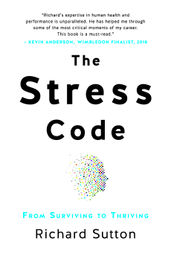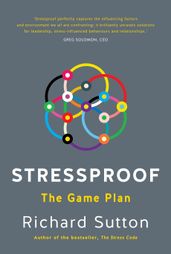Stressproof: the game changing action plan for managers, leaders and decision makers
“The role of connectivity and meaningful relationships is equally important in the actualisation of human potential. Social bonds, care, protection, guidance, support and shared identity form the backdrop to self-actualisation by providing direction, safety and confidence in all that we are likely to experience during the course of our lives.”

The world faces a ‘giant storm’ of stress and burnout that is exacerbated in the context of the COVID-19 pandemic and the Fourth Industrial Revolution. Learning how to navigate the world going forward is something that everyone has to do. How can leaders help themselves, their employees and their businesses to thrive in the face of these and other challenges? Here, Richard Sutton, an adviser on stress management and bestselling author of The Stress Code, speaks on the crisis currently facing the professional landscape and stress-related challenges facing decision makers in the world of business today.
How does Stressproof differ from your first book The Stress Code?
With The Stress Code the focus was on self-actualisation and successfully adapting through adversity. The emphasis was bring together mindset, behaviour, self-awareness and health practices in a model that offers the greatest protection during stressful events. The narrative of Stressproof differs in that it centres on the wellbeing and potential others through stressful events. It outlines our role in protecting and buffering them from the numerous insurmountable challenges that we are confronted with today. It is story about leadership through crisis and how to bring out the potential that exists within your teams, business, family and overall sphere of influence.
Like The Stress Code, this book is based on detailed and meticulous research – what was the most surprising article or report you read while working on Stressproof?
The article that really stood out was by Michael Mankins from Bain & Company. It talked to the power of inspiration in transforming businesses and people, but most importantly it spoke to what it takes to inspire the people.
One of the key themes in the book is that leaders need to recognise the value in people – do you have a real-life example of how effective this is from your experiences?
I have personal experience that really brings this point home – the story of Kevin Anderson and his journey into the top 5 tennis rankings.
You describe great leaders and great managers and the differences between the two – could you give us some well-known examples of both?
I think we all know great managers. It’s a unique ability that is exemplified by risk aversion especially to failure, strong goal orientation, the ability to enhance and build existing systems, the ability to fit into any culture and have the capacity to really refine their existing skills.
Leaders, especially during this time are very different in many respects. They are principally change agents. They are not overly risk averse, do not readily conform, have their own unique brands, are always learning new things and live very much in the future to the exclusion of the present. They are very reliant on a coalition of managers to achieve their success. My best examples of leaders include Steve Jobs and Rassie Erasmus.
How can managers and leaders recognise when work pressure has become too stressful and is making their team dysfunctional?
In a society where weakness is not readily tolerated and vulnerability frowned upon it is often difficult for leaders to see beyond the mask. The first thing leaders need to be mindful of is burnout. Look out for the following shifts:
- Emotional exhaustion
- Detachment
- Poor overall sense of accomplishment
- Physical exhaustion
- Negativity and cynicism – especially towards job
- Reduced professional ability
At the same time, burnout is often superimposed upon presenteeism (coming to work disengaged, disconnected, unwell and disinterested). Presenteeism is often a consequence of chronic stress and reflects in:
- Greater frequency of errors
- Difficulty concentrating
- More frequent emotional outbursts (aggression, crying, impulsive behaviours)
- Greater indecisiveness
- Forgetfulness
- Difficulty in creating structure and planning
If 2 or more signs from each list present themselves over a period of several days, intervention is needed.
The book explains the importance of leaders taking time to ensure the wellbeing of their – team, community or family. Who is responsible for nurturing and supporting leaders so that they can do this?
Such a great question.
This was the central theme of The Stress Code. The message contained within the book was the importance of self-care. Our own potential lies within two fundamental areas - strong social connections and health. Within the context of social connections I have come to learn from elite sportsmen and women as well as corporate leaders (with some science to back it up of course) that our success is completely dependent of the input from others. This is why I feel the Young Presidents' Organisation ( YPO) is such a strong leadership forum. It is an environment where successful individuals can come together and support each other in their successes and through their challenges. The other primary influence on our potential is health and wellbeing. Countless studies in the area of resilience (the ability to successfully adapt in the face of adversity) show that the greater one’s health and fitness, the better ones ability to withstand stressful events. In other words to be a great leader which entails the ability to successfully support and buffer your teams in these difficult times, you will need to look after your own health and develop and nurture relationships.
Discussions about the dangers of "toxic positivity" are becoming more common on social media. The book does suggest optimism is important but how can leaders avoid silencing the people they are involved with and develop authentic support while still remaining optimistic?
Let’s first define toxic positivity. Simply put it is the excessive and ineffective overgeneralization of a happy, optimistic state across all situations. The process itself results in the denial, minimization, and invalidation of authentic human emotional experiences. It is at its core it is completely inauthentic behaviour and no one likes that.
At the same time when it comes to leadership in these times optimism is an imperative. I have never come across a successful team or athlete who doesn’t possess this key characteristic. But, I would like to point out that optimism should not be confused with denial or minimisation of circumstances. Instead it represents hope and belief in a better reality. Martin Luther King Jnr and Nelson Mandela could be defined as highly optimistic leaders. This is not to say that they didn’t deeply reflect on acknowledge the challenges of the time (as opposed to dismiss them), however it was with a view of a better future – the promised land.
Which global leaders (if any...) do you think best embodies the leadership principles you identify in this book?
I think there several that have inspired me personally and embody the principals outlined in the book. These include Nelson Mandela, Martin Luther King Jnr, Winston Churchill, Oprah Winfrey, Lord Rabbi Jonathan Sacks and Siya Kolisi. Not only did/do they inspire change, but they lead by example, were/are champions of morality, were/are deeply compassionate, fully committed/commit themselves to the wellbeing of others, gave/give people a voice, uplifted others and were always visible throughout the most challenging times.
Presenteeism is a commonly used term in the book, could you give us a definition and describe its impact in the workplace
Presenteeism is the practice of going to work despite illness, injury, anxiety, often resulting in reduced productivity and reduced employee engagement and inspiration.
It is typically a result of stress related emotional or physical compromise. The primary triggers in presenteeism include:
- Depression
- Anxiety
- Allergies
- Physical pain
It is extremely costly on businesses and the broader economy. A large multinational study recently calculated that presenteeism cost the south African economy $14.8 billion (R229 billion) annually.
How do you define burnout?
We often construe burnout as purely a state physical exhaustion and feelings of depletion. Unfortunately its impact is far more profound and in many ways destructive. Firstly, it often manifests first as behavioural volatility and emotional exhaustion. From this point it may develop into detachment and depersonalisation with growing negativity and cynicism (especially pertaining to ones job). As burnout progresses one’s personal worth begins to corrode as a the sense poor overall accomplishment becomes a perceived reality. It finally culminates in reduced professional ability as all reserves have depleted.
It would be extremely advantageous within the context of organisational potential to prevent burnout where possible. This would require creating a culture that is committed to health and wellbeing, while at the same time carefully monitoring demands, overcommitment and working hours.
The fourth industrial revolution is flagged as a key stressor but also has the potential to change our lives for the better. Could you outline why it could be stressful and also how do we buffer the stress that it causes?
The Fourth Industrial Revolution has brought with it change on an unprecedented level and at a speed that is almost unfathomable. These monumental changes and shifts have changed the way we live, learn, relate to one another and work. The reason it has affected us to such an extent is that human stress is caused primarily by the sense that we lack of control, ongoing uncertainty and social distance/isolation. This means that leaders can mitigate much for the stress through two action steps:
- Giving your team/s a sense of control in their lives
- Making people feel valued, needed and part of something bigger
To promote a sense of control it is important to create an environment that centres on allowing for individual choices (within established parameters), accepting that mistakes are part of the growth and success journey, building trust, allowing for individual ownership of projects and providing a stable environment for interaction.
To address the sense of isolation and loneliness one would need to create an environment that champions social connections and mutual support. You could include:
- Team-building exercises
- Shared learning experiences
- Group projects, and
- Collective accountability
This said, it is equally important to create an environment where your workforce is able to share a collective identity. This means they have to take pride in the company’s values, ethos and moral code – ultimately it is what will bring a team together. One final tip – make an effort to check in personally with those directly under your care and encourage all leaders and managers to do the same.
What do you hope people will take away from the book and what do you hope it will achieve?
There are four important messages. The first is to highlight the destructive impact of chronic stress on human immunity, the brain and digestive system – essentially this provides context as to what people are going through right now. The second message talks to why the world is currently grappling with stress and mental health challenges to this degree. As a leader in order to successfully promote positive change, one has to clearly understand the landscape. The third message is the socioeconomic consequences (on one’s business and the broader economy) of inaction. The final message talks to what we all need to do to create a new reality – in other words the actions steps.
More so now than at any point in recent history, our leaders have the power to shape a better future. Through a better a understanding and of the current stress landscape and modifiable influences, decision makers have the potential to unlock unimaginable creative and innovative potential, unlimited discretionary energy and improve the health and wellbeing of those under their care.
The Stress Code
by Richard Sutton
Stress impacts all facets of our lives and it is having devastating effects on the global economy. Effects such as reduced productivity and the huge burden being placed on healthcare systems around the world. Research has revealed that stress can destabilise our DNA, thereby compromising our genetic integrity, leading to the increase in many of the diseases we as a society are grappling with. Stress on an ongoing basis is one of the biggest challenges faced by the human race but in short bursts it can actually offer tremendous potential to grow, break personal barriers and excel.
This book is therefore one of resilience not avoidance. Full of tools and skills to buffer the adverse effects of stress and enhance functionality and health, The Stress Code is a response to the global call for stress management solutions. Supported by extensive scientific research, the book offers comprehensive and structured insights and interventions to assist in thriving in adversity.
Stressproof
by Richard Sutton
The world faces a ‘giant storm’ of stress and burnout that is exacerbated in the context of the COVID-19 pandemic and the Fourth Industrial Revolution. Learning how to navigate the world going forward is something that everyone has to do. How can leaders help themselves, their employees and their businesses to thrive in the face of these and other challenges?
Stressproof speaks to the crisis currently facing the professional landscape. It outlines the conundrum of stress and its performance advantage versus its destructiveness; and it focuses on the stress-related challenges facing decision makers in the world of business today.
Practical, insightful and based on case studies and real-world examples, Stressproof provides a game-changing action plan to help managers, leaders and those who are making decisions.



